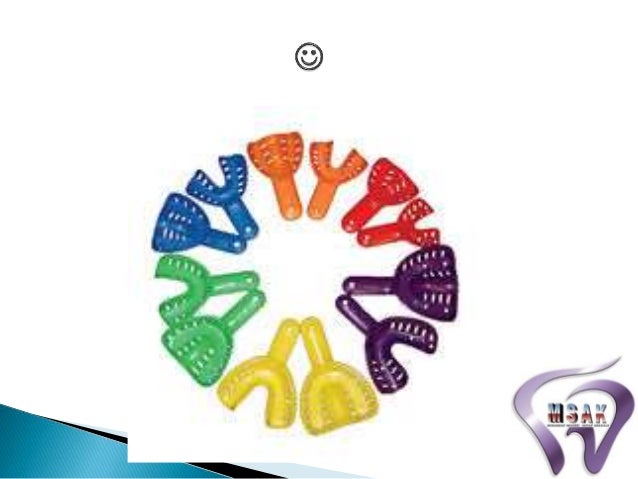
Dentist must guide the patient into centric occlusion as he/she bites into the material. With this technique, one impression records oral structures of both the arches as well as occlusal relationship. This is why, triple tray is commonly used with agar. Impression removed suddenly with snap (viscoelastic behavior).ġ6 TRIPLE TRAY TECHNIQUE Even sufficiently viscous material sometimes does not offer much resistance to seating making easy for the patient to bite through it. Lower the temperature, more rapid is the gelation and stronger the material. Gelation is accelerated by circulating cool water (18-21⁰C) through the tray for 3-5 min.

Gauze pack and outer layer of agar is removed from tempering bath, transferred into stock tray and seated with light pressure. Just before completion of tempering for tray material, low viscosity material syringed directly from storage compartment is applied to prepared tooth (first applied to the base, then rest of the preparation covered). Syringe material is never tempered but always maintained in a fluid state to enhance adaptation to tissues.

To ensure that agar temperature is <55⁰C. For immediate preparation step : hydrocolloid sol removed from storage bath, tray filled with sol, gauze pad placed over it, placed in water filled tempering container at 45⁰C. The material can be stored for several days, therefore, a number of tubes and syringes can be prepared for use throughout a week or so.Ħ5⁰C is too hot for the oral tissues, therefore, the material used to fill the tray must be tempered. After liquefaction, the material may be stored in the sol condition at 65⁰C until needed for injection into prepared tooth or for filling a tray. THE THREE COMPARTMENTS ARE USED FOR LIQUEFYING THE MATERIAL, STORING AFTER BOILING, AND TEMPERING THE TRAY HYDROCOLLOID.ġ1 Step 1: Preparation and conditioning of the agar materialįirst step is to liquefy the hydrocolloid gel in boiling water for at least 10 minutes. Equipment should be calibrated weekly.ġ0 CONDITIONING UNIT FOR AGAR HYDROCOLLOID IMPRESSION MATERIALSĬONDITIONING UNIT FOR AGAR HYDROCOLLOID IMPRESSION MATERIALS. Temperatures in each of the step are critical. Three compartments in conditioning unit make it possible to simultaneously liquefy, store, and temper the hydrocolloid. Placing it in the impression tray tempering it to a lower temperature that the patient can tolerate maintenance of fluid state to capture details of oral structures once in the mouth, material is cooled below mouth temperature to ensure gelation ALSO SHOWN IS THE HOLDER FOR CARRYING THE AGAR INTO THE CONDITIONING UNIT.Ĩ MANIPULATION Manipulation includes: liquefying the gel Differences between two forms are the color and a greater fluidity of the syringe material.ħ CARTRIDGE OF AGAR HYDROCOLLOID AND SYRINGES USED FOR INJECTING ONTO THE PREPARED TOOTH. Tubes are used to fill the water-cooled trays and cartridges for use with the syringes.

As a tissue conditioner.Ħ SUPPLIED AS Two forms: Syringe material Tray material Previously used for FPD impressions prior to elastomers.
#Agar dental impression material full#
during fabrication of cast metal removable partial dentures, etc.) For full mouth impressions without deep undercuts. TYPE I – high consistency (for use as tray material) TYPE II – medium consistency (for use as tray or syringe material) TYPE III – low consistency (for syringe use only)ĥ USES For cast duplication (e.g. An organic hydrophilic colloid (polysaccharide) extracted from certain types of seeweed.ģ COMPOSITION OF COMMERCIAL REVERSIBLE HYDROCOLLOID IMPRESSION MATERIALSĬomponent function composition(%) agar brush-heap structure 13-17 borate strength sulfate gypsum hardener wax, hard filler thixotropic materials thickener water reaction medium balance as required in the production of dies for fixed restorations. Presentation on theme: "AGAR (reversible) hydrocolloid"- Presentation transcript:Ģ DEFINITION An aqueous impression material used for recording maximum detail e.g.


 0 kommentar(er)
0 kommentar(er)
